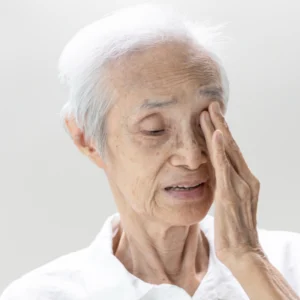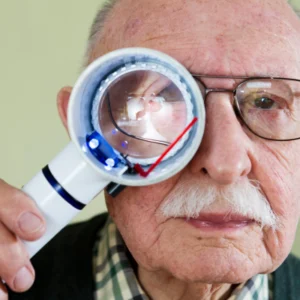Imagine waking up one day to find the world around you slightly off-kilter. The faces of your loved ones appear blurry, and the lines on your favorite painting seem to dance and waver. This is the subtle yet unsettling onset of macular degeneration, a condition that gradually alters how we perceive our visual world.
Macular degeneration is a chronic eye disease affecting the macula in people over 55. It primarily impacts central vision, with two types: dry and wet. Early symptoms include blurry central vision and difficulty recognizing faces. Regular eye exams from Hardin Valley Eyecare and Optical are crucial for early detection and management.
What is Macular Degeneration?
Age-related macular degeneration (AMD) is a chronic eye disease that affects the macula, the central part of the retina responsible for sharp, detailed vision. It typically occurs in people over 55 and is the leading cause of blindness in industrialized countries.
There are two main types of macular degeneration: dry AMD and wet AMD. Dry AMD makes up the majority of cases. It involves the gradual thinning of the macula and the accumulation of drusen (cellular waste). Wet AMD is less common but more severe. It’s caused by abnormal blood vessel growth under the retina.
Both types primarily impact central vision while your peripheral vision usually remains intact.
Early Signs and Symptoms

Early signs of macular degeneration often develop gradually and can go unnoticed for a long time. One of the first symptoms is blurry or fuzzy vision, particularly in the central field of view. You may experience difficulty recognizing faces, even those of close friends and family members.
Another early indicator is the need for brighter light when reading or doing close-up work. You may find yourself increasing illumination to compensate for reduced visual acuity. Additionally, you may have trouble adjusting to low-light environments, such as when entering a dimly lit restaurant or theater.
Other early signs can include:
- Decreased night vision
- Reduced color perception
- Mild blurry vision
It’s crucial to note that these symptoms can occur even with mild vision loss. This makes it essential to get regularly scheduled comprehensive eye exams for early detection and the management of macular degeneration.
What Does Macular Degeneration Look Like as it Progresses?
“What does macular degeneration look like as it progresses?” is a common question as people get older and learn more about the condition. Visual symptoms become more pronounced as macular degeneration progresses.
For example, color perception continues to decline as the condition worsens. Colors may appear less vibrant or dull and you might struggle to distinguish between similar hues, particularly blues and purples or pinks and oranges.
The distortion of shapes becomes more evident, with objects appearing smaller or differently shaped than they actually are. This can lead to difficulties with depth perception and spatial awareness. Similarly, straight lines also appear worse.
As macular degeneration advances, dark or blurry areas may develop in the central vision, creating blind spots or scotomas. These areas can interfere with activities requiring detailed vision, such as driving or reading.
Advanced Visual Changes
Symptoms become more severe as macular degeneration progresses to advanced stages, sign

ificantly impacting your daily life. While your peripheral vision usually remains intact, the loss of central vision can significantly reduce your independence and quality of life as your condition worsens into advanced macular degeneration.
The loss of central vision becomes more pronounced making it challenging to see objects directly in front of you, including faces of family and friends. Central vision loss can be gradual in dry AMD or sudden in wet AMD.
Advanced macular degeneration severely impacts daily activities. Reading becomes increasingly difficult, with words appearing missing or blurred in the center of the page. Driving becomes dangerous due to the inability to see road signs or other vehicles clearly. Other tasks like watching television, cooking, or recognizing faces also become challenging.
Diagnosis and Testing
Regular eye exams are crucial for early detection of age-related macular degeneration, especially if you’re over the age of 50. Optometrists use various tests, including pupil dilation and retinal photography, to diagnose AMD.
The Amsler grid test is a simple yet effective tool for detecting early signs of AMD. You focus on a central dot in a grid pattern, noting any wavy, distorted, or missing lines This test can be performed at home, but it doesn’t replace comprehensive eye exams by your eye doctor.
Treatment and Management
While there’s no cure for AMD, early intervention and proper management can significantly preserve vision and quality of life. Early detection is crucial since treatments are most effective when started promptly.
Treatment for AMD depends on the type and stage of the disease. For dry AMD, vitamin supplements can slow progression in intermediate to advanced stages. Wet AMD is primarily treated with special injections to slow vision loss.
Choose Hardin Valley Eyecare and Optical for Your Vision Health
Hardin Valley Eyecare & Optical is the best choice for comprehensive eye exams that screen for macular degeneration. Led by experienced optometrists Dr. Travis Thompson and Dr. Catherine Abbott, we offer state-of-the-art diagnostic technology and a wide range of eye care services.
We provide flexible appointment times to accommodate busy schedules, with convenient hours six days a week. With access to advanced imaging tests and a focus on early detection, Hardin Valley Eyecare & Optical is well-equipped to help you maintain optimal eye health and manage macular degeneration effectively.
Age-related macular degeneration is a chronic eye condition affecting central vision in people over 55. It has two types: dry (common) and wet (severe). Early signs include blurry vision and face recognition difficulties. As the disease advances, visual distortions worsen, impacting daily life. Regular eye exams are essential for early detection and effective management.
Hardin Valley Eyecare & Optical has been serving Knoxville since 2009. Located at 10904 Spring Bluff Way, you can schedule an appointment online or call us at (865) 888-0892.






